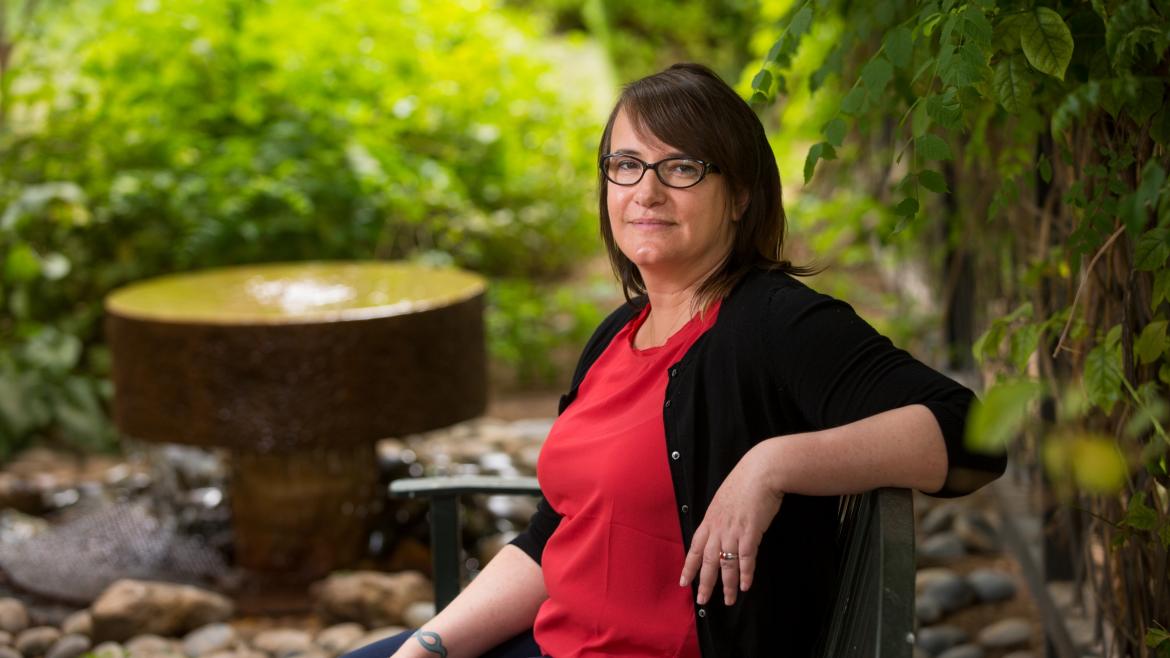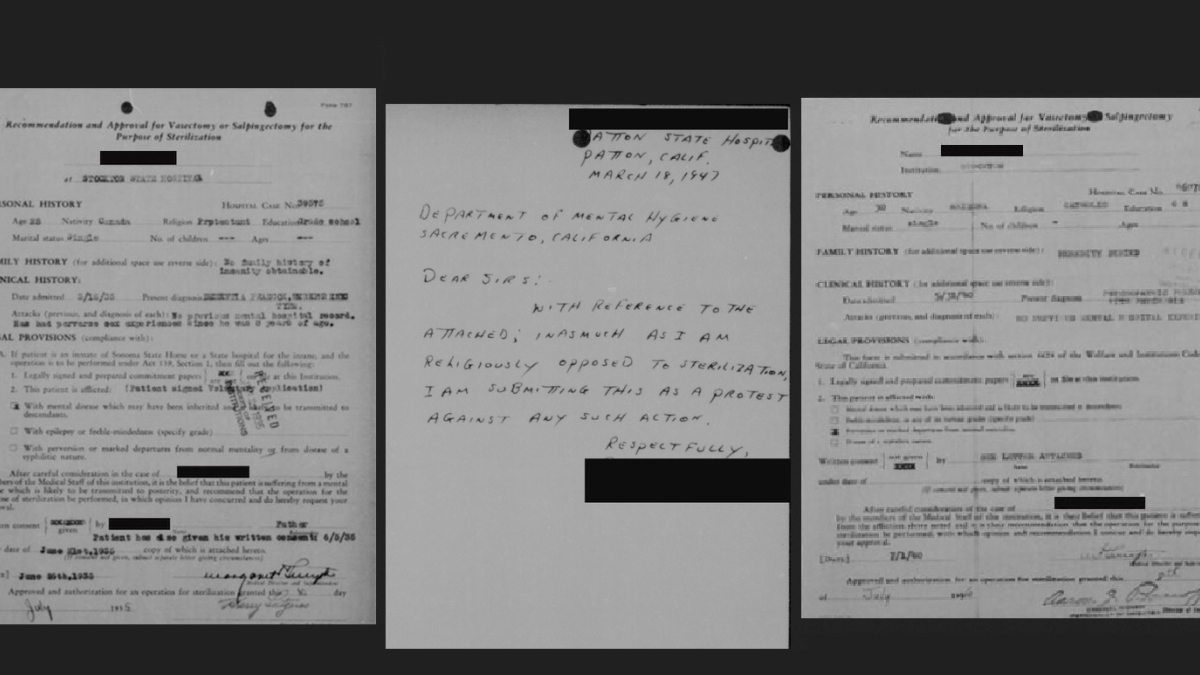At a large, state-run medical facility, a young woman’s reproductive fate has been determined. The medical director presiding over her case carefully types out a letter requesting authorization to have her sterilized, citing “recent thefts” and her admission of having “sexual relations” with a young man as the rationale.
This isn’t the beginning of a dystopian novel; this really happened.
And not in some far-off, foreign land. This happened in the United States — in this particular case, in California in 1938 — as the result of the eugenics movement of the early 20th century.
With the hope of gleaning something valuable from this heinous chapter of American history, ASU assistant professor of English Jacqueline Wernimont has teamed up with colleague Alexandra Minna Stern at the University of Michigan on a project called the Eugenic Rubicon.
The Eugenic Rubicon serves as a digital resource on the history of eugenic sterilization in the U.S., providing archival documents, data visualizations and more. It began in 2013 when Stern and her team first discovered the eugenics records, which then had to be hand-entered over the course of several years into a HIPAAThe Health Insurance Portability and Accountability Act was passed in 1996 and has strict rules about the privacy of medical records. -compliant database. Wernimont and Stern recently received a $40,000 NEH Humanities Collections and Reference Resources (HCRR)The Humanities Collections and Reference Resources program is part of the National Endowment for Humanities and supports projects that provide an essential underpinning for scholarship, education and public programming in the humanities. seed grant that will enable the ASU-UMichgan team to develop a protocol for making sensitive records available online, thus ensuring a balance between the public right to know about this horrific history and patient privacy rights.
“One of the things that’s really exciting to me about this grant is that because it’s made by a federal organization, it gives us an opportunity to highlight this history not just for the general populace but for lawmakers, Congress members, senators, etc., both at the state and federal level,” said Wernimont. “That sort of historical, community engagement and public policy nexus is potentially one that is quite powerful for social change.”
In 1907, Indiana became the first U.S. state to pass a eugenics law allowing for the sterilization of those deemed to be of diminished mental capacity, which often meant they had a history of criminal behavior but could also mean they were simply “peculiar” — more on that later.
Thirty-one states, including North Carolina, Virginia, Arizona and California, would later follow suit. By the 1970s, at least 60,000 people had been sterilized as a result of eugenics laws — 20,000 in California alone — many against their will.
It all started when evolutionary science and the idea of hereditary genetics became mainstream. In California, the concept gained popularity when it was applied to agriculture to improve crop and livestock yields and quality.
Then it took a dark turn.
California was also seeing a rise in the amount and prestige of institutions where the practice of eugenics was seen as a way to strengthen the nation.
“Aside from the insane implications for disability rights — that people who are in some way disabled aren’t fit to have children — there are a number of ways in which those metrics were less about mental capability and more about social behavior,” Wernimont explained. “So a person could be considered lower on the intellectual scale if they couldn’t control their sexual desires — both men and women — or if they were known to have committed misdemeanors, things like theft of food, harassment of people … but things that are pretty common if you’re in fiscal straits.”
Perhaps surprisingly, the majority of those sterilized when the first eugenics laws were passed were males, as the method of sterilization — vasectomy — was already a widely practiced, fairly low risk procedure that was seen as an easy way to prevent sex offenders and petty criminals from reproducing. Later, in the 1920s and 1930s, as steralization became more widely practiced, the demographic of those undergoing sterilization shifted disproportionately to femalesUntil the 1960s, sterilizations on women were called salpingectomies (salpingectomy) and involved severing the fallopian tubes, sometimes transvaginally and later more transabdominally; tubal ligations came later in the 1960s. For men, the procedure has always been called vasectomy.. Part of that is likely due to the lack of effective, accessible birth control. For some women, having themselves committed in order to be sterilized was the only alternative.
“There are some records of particular hospitals where people come in and then are released very quickly that seem to be precisely this kind of thing,” said Wernimont. “Additionally, the records show those being committed are very often women from underrepresented minority groups. So we have a high proportion of women with Spanish surnames who were sterilized. You also have a large number of Catholics who were sterilized. So there are these intersecting social issues that are coming to bear on peoples’ bodies.”
One of them being the fear of an encroaching immigrant population.
“It’s also the case that you have a very high population of Latino and Latina people [in California]," Wernimont said. "And also Native Americans. And there is a long-standing rhetoric around people of color who can’t control their reproductive capacity, so they are seen as a threat and need to be controlled. …
“There’s a set of things in California, both the prestige of the institutions, the existence of several hospitals in the area that were feeders for this kind of sterilization, and then this kind of sentiment in the West that there were all of these highly fecund brown people who were threatening to colonial settlers in the 20th century.”

ASU assistant English professor Jacqueline Wernimont is hoping to glean something valuable from a dark chapter in American history.
Photo by Charlie Leight/ASU Now
In many cases, language barriers and the underrepresentation of the mentally ill at the time presented a situation in which informed consent was questionable. There are even instances of girls as young as 13 being sterilized with the explanation that “although this girl’s IQ would place her in the normal class, her poor practical judgement and flighty unstable mentality tends to place her in the class of the feebleminded.”
“It speaks very powerfully to how men thought they could control women, and how they put it under the guise of genetic improvement,” said Wernimont. “As if what the nation needed in the moment right after enfranchisement of women was to take their bodies and do something to them such that they could not reproduce.”
In some states, such as North Carolina and Virginia, reparations processes have begun, thanks to journalist reports that revealed what many knew but few could confirm. But due to privacy rules under HIPAA, obtaining records from institutions that practiced sterilization is often an exercise in futility.
“[Laws like HIPAA] are really interesting guidelines because they are in some ways a mechanism that states can hide behind,” said Wernimont. “In the case of the North Carolina sterilization records, they were actually destroyed by the state. So just getting access to the records is a problem.”
Whatever documents can be obtained are also subject to strict HIPAA regulations that require no personally identifying information be revealed. In the case of the Eugenic Rubicon project, that makes it very hard to convey the humanity of those who underwent sterilization to the general public viewing their stories — which is kind of the whole point.
“One of the things that’s been really interesting to me is the ways in which these peoples’ bodies weren’t considered valuable and their own desires weren’t considered valuable. Except that extensive records were taken to make the case that their bodies could be transformed. But then those records, despite having been made and been quite extensive, were then sort of left disregarded. So it’s a kind of double slight of the people, both of their physical bodies, but then that body of record,” said Wernimont.
“So for me, it’s really important to think about what does it mean to re-embody first that knowledge and to show care for those documents that were discarded, but also to show care for those bodies that were uncared for. What does it mean to extend a hand backwards into time and say we care that this happened?”
Unfortunately, not everything about the practice of eugenics is history. Although eugenics laws began to be repealed in the 1970s, instances of forced and/or non-consenting sterilization have been reported as recently as 2010 at two separate California state prisons. California Gov. Jerry Brown has since signed a law making non-consenting sterilization of inmates illegal. However, the real concern is that it was allowed to happen in the first place.
“These are histories that keep going,” said Wernimont. “And part of why it happens, in the case of the California prisons, is those were instances where a single doctor or a set of doctors had extraordinary power and were able to ... do it in relative silence because of their position of power.”
The same situation plays out, said Wernimont, when you have immigrants, minorities or people from underrepresented groups who don’t have the agency to speak out about how they were wronged.
Wernimont and Stern are hoping for and actively seeking further funding for the Eugenic Rubicon project, so that it has a chance to reach an even wider audience — and maybe even enact real social change.
Top photo used in accordance with the California Committee for the Protection of Human Subjects Protocol ID 13-08-1310 and the University of Michigan Biomedical IRB HUM00084931.
More Arts, humanities and education

ASU professor's project helps students learn complex topics
One of Arizona State University’s top professors is using her signature research project to improve how college students learn science, technology, engineering, math and medicine.Micki Chi, who is a…

Award-winning playwright shares her scriptwriting process with ASU students
Actions speak louder than words. That’s why award-winning playwright Y York is workshopping her latest play, "Becoming Awesome," with actors at Arizona State University this week. “I want…

Exceeding great expectations in downtown Mesa
Anyone visiting downtown Mesa over the past couple of years has a lot to rave about: The bevy of restaurants, unique local shops, entertainment venues and inviting spaces that beg for attention from…


